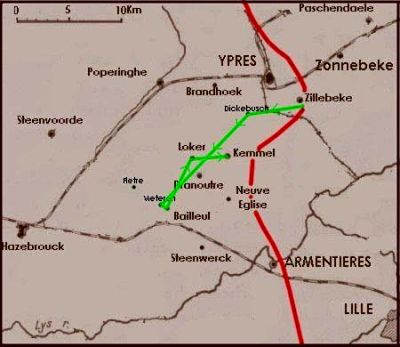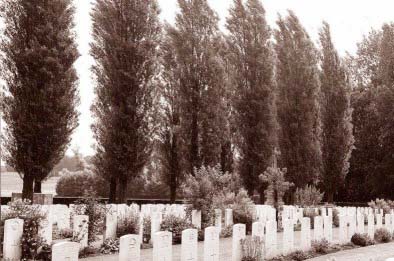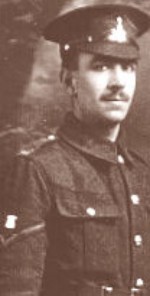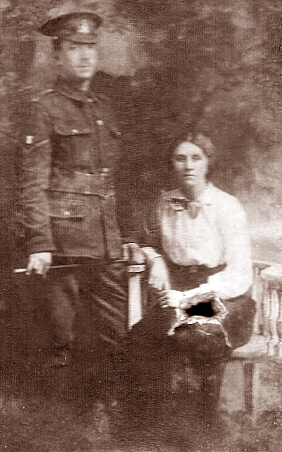 The Battalion moved from the trenches in Armagh Wood on 28th March and via Dickebusch, Meteren,
Bailleul and Locre ended up on the 31st taking over trenches in front of Kemmel.
The Battalion moved from the trenches in Armagh Wood on 28th March and via Dickebusch, Meteren,
Bailleul and Locre ended up on the 31st taking over trenches in front of Kemmel.
|
28th MARCH. The Bn moved to billets in the Meteren area, a village just to the West of Bailleul, taking
over from 13th Canadian Bn.
30th MARCH. Bn moved via Bailleul to Locre and took over HQ, QM stores and Transport lines from 28th
Canadian Bn.
31st MARCH. The Bn took over trenches [G1 to H1A] in front of Kemmel from 31st Bn Canadians.
1st to 4th APRIL. Generally quiet and working on trench improvements. The Officer Commanding 50th Division,
Brig Gen B G Price came round the trenches with Staff Officers.
Capt Sproxton took over command of Y Company from Lt Thornton to command W Company.
5th APRIL. Germans trench mortared G1, G2 and H1A trenches without doing much damage but 4 other ranks were
wounded.
6th APRIL. Slight trench mortaring. Robert the swan was killed by shell fire.
7th APRIL. Severe shelling by the Germans behind G1 and G2 from 3 to 5 p.m.
The Bn were relieved at night by 5th Bn D.L.I. 2 Lewis guns handed over to them. "X" Company were left in Support
at Kemmel Chateau. The other 3 Companies went into Kemmel Shelters. 2nd Lt N H Laing and 4 other ranks had been
wounded during the spell at the Front.
8th APRIL. 100 men supplied at night for working parties, 45 as miners.
|

Kemmel Chateau Military Cemetery.
The Chateau stood to the North East of the village of Kemmel until being destroyed by shell fire.
The Cemetery was made in the Chateau grounds.
15 men of the 4th Yorks Battalion are buried here.
[Picture courtesy of - "WW1Cemeteries.com".].
|
Capt Sproxton was decorated by H.M. King George V with the Military Cross.
9th to 14th APRIL. Usual working parties were supplied. A Draft of 75 other ranks were received as
reinforcements.
12th APRIL.
25168 Pte Smith Henry. Home at Grangetown Middlesbrough, place of birth and enlistment.
Died at home and buried at Eston Cemetery.
15th APRIL. The Bn relieved 5th Bn D.L.I. in the same trenches, Z Company remaining in reserve at Kemmel
Chateau.
16th APRIL. A fine warm day followed by a wet night on which the Germans did considerable damage to trench
G2 with mortars. No casualties.
17th APRIL.
1329 Pte Wilson Ambrose. Born and home at Yarm, N Yorks. Killed in action.
Buried at Kemmel Chateau Military Cemetery.
It was the anniversary of the Battalion's arrival in France and the Diary gives a summary of
the losses suffered during the year. Only 7 Officers remained of those who came out and two of them had spent
4 months in England wounded.
|

Pte P R Macfarlane.
|
These were Captains Charlton, Fawcett, Rowlandson, Stead and Hewitt.
Lieutenants Thornton and Constantine.
14 had been killed or died of wounds. 3 Gassed. 1 Shell Shock. 6 had been evacuated to England sick or other
causes. 6 had been transferred or attached to other Units.
163 Other ranks had been killed or died of wounds. 6 were Missing. 4 had been taken Prisoner.
478 had been wounded or gassed.
To celebrate the day Wick gave birth to 2 puppies at 1 a.m. All doing well.
18th - 21st APRIL. Fairly quiet time but on the 21st there was a small bombardment of trenches G4 and H1A.
Little damage was done to the trenches, but 1 other rank was killed.
1402 Pte Porritt William. Home at Lingdale, N Yorks. Born at Kiltonthorpe and
enlisted at Skelton in Cleveland, N Yorks. Killed in action. Buried at Kemmel Chateau Military Cemetery.
22nd APRIL. Moved to huts at Locre where for 4 days they supplied working parties and examined kit.
27th APRIL. The Bn marched to a rest area at Fletre, a village to the North West of Bailleul.
It was an extremely hot day and they arrived there at 6.30 p.m.
|

Pte P R Macfarlane and his wife with Bullet hole.
|
The area allotted was inadequate for the strength of the Bn and they were scattered over a wide area that was deficient
of latrines or wash places.
The one thing in their favour was the weather and men preferred sleeping out in the open rather than "evil
smelling barns".
266 Pte Macfarlane Peter, Reuben was discharged from the Army on the 16th April 1916 at the age of 26/27, after being wounded on some unknown date.
It is said he was saved from death by a "baccy" tin that stopped the main force of the bullet.
A photo with a bullet hole through it that he kept in the same pocket is shown here.
As his low Battalion number shows he had served with his local 4th Yorks Company before the war and was with the Battalion when they first went out to France on 18th April 1915.
He died in 1978, two weeks short of his ninetieth birthday and had told his family that he was the bugler at the consecration of Middlesbrough War Memorial.
He was one of five brothers who served in the First World War, two others of them in the Yorkshire Regiment. The youngest lost one of his legs, the amputation being performed by the Germans using paper bandages, which were used extensively by them as they were short of raw materials.
The father of the five lads was at the same time a ship's engineer in the Merchant Navy.
Peter's wife was his cousin, Frances (nee Norris) from Sowerby near Thirsk.
They had six children, Duncan (1915), Peter (1917), Gordon (1918), Olga (1919), Jean, my mother(1921) and Alma (1928).
Peter, Olga and Alma all died in infancy, but the others made it through and had families of their own.
|
As regards the baccy tin, the family gag was the saints were watching over him....especially St. Bruno....but that would probably mean nothing to most people nowadays, although I'm sure you would get the reference.
[The photograph and information has been kindly contributed by Peter's Grandson, Ray Cox.]
|
|



